Ahead of its mid-November launch MINI has released information on the driver assistance technology to be found inside the all-new F56 model. In doing so we get a small preview of the car’s interior, at least the central screen in which much of the technology is viewed or accessed.
For the first time MINI will feature a head-up display. This will be projected onto a small folding screen in front of the driver, rather than on the windscreen as seen in similar systems.
Other technology includes collision and pedestrian warning with city braking function, speed limit info, traffic sign memory and no passing info, video-based speed and distance regulation, park assist, rear view camera and digital headlight assist.
Much of this technology relies on inbuilt cameras interpreting signs on the side of the road and filtering it into the driver’s in-car viewing. We wonder how accurate or useable these systems will really be.
More detail and pictures can be found after the break.
The new MINI driver assist systems.
10.10.2013
Intelligent networking between the MINI, the driver and the outside world create new ways to enhance driving pleasure, extend the range of comfort functions and provide the latest services in the area of in-car infotainment. Since its launch, MINI Connected has been marketing leading in the area of in-car technology, pioneering access to apps and services to both assist and entertain driver and passengers.
In future models MINI will roll out a number of innovative driver assist systems that also use intelligent networking for the exchange of information between driver and vehicle. The new functions transform the MINI more than ever into its driver’s assistant and offer innovative comfort and safety technology.
When it comes to the development and configuration of new driver assist systems, MINI exploits the BMW Groups’ worldwide leadership in innovation in this area. Networking technology has been used for the targeted exchange of information between driver, vehicle and the outside world for more than 40 years. Innovations like the radar-based distance warning device (1972), the world’s first on-board computer with exterior temperature display (1980), the first navigation system fully integrated in the vehicle from a European manufacturer (1994) and first Emergency Call system, still unique to this day, first introduced in 1997, are among the milestones set by the company in this area. As early as 2007, interface technology for integrating the Apple iPhone in the MINI operating system was introduced. Since 2011, additional online-based functions can be integrated in the MINI Connected package with the help of apps.
The MINI head-up display helps the driver concentrate on what is happening on the road by displaying relevant information right in the driver’s line of vision. This can be seen quickly and conveniently without having to take your eyes off the road. The collision warning and pedestrian warning systems, including city braking function make it easier to avoid dangerous situations, particularly in city traffic. The MINI parking assist feature offers maximum comfort in searching for and using parking spaces, while the reversing camera gives drivers a better view when manoeuvring.
Other innovations in the driver assist systems for MINI include the video-based speed and distance control which automatically keep a safe distance from the vehicle in front, and the speed limit information system, which detects and displays speed limits as they apply to the current section of road. This system is supplemented by the no passing display and traffic sign memory functions. The digital headlight assist function contributes to optimum visual conditions when driving at night. This system helps the driver use the full range of headlight functions. Oncoming traffic and preceding vehicles are registered by a camera, while automatic switching to dimmed headlights avoids causing a nuisance for other drivers.
2. The new MINI driver assist systems.
2.1 MINI head-up display.
The head-up display which will be available for future MINI models ensures that drivers always have all the relevant driving information in full view. This information is displayed above the steering wheel and therefore directly in the driver’s line of vision. This means that the information can be assimilated up to 50% faster, while the driver’s attention is focused where it is needed – on the road.
The BMW Group presented a head-up display in a series production car for the first time in 2003. The version of the head-up display specially designed for MINI reinterprets the principle and instead of projecting the information onto the windscreen, displays it on a small folding display in the top part of the dashboard between the front window and the steering wheel.
The MINI head-up display supplies important driving information as a high-resolution colour image in the driver’s line of vision. A clearly differentiated colour scheme makes it easy to distinguish between general information like speed limits and navigation data and urgent warnings, thus reducing the corresponding response time. The contents that the MINI head-up display can show, as well as the permanently displayed speed, depends on the model and equipment. In addition, the driver of a MINI can configure the contents of the MINI head-up display by means of the vehicle’s operating system.
The information that can be displayed in the MINI head-up display includes the speed in numbers, navigation instructions in arrow-based graphics and junction layouts, optical signals for collision warnings, display symbols for the speed limit info and no passing display systems, and details of the entertainment program, such as radio channel or music track. The graphic displays on the high-resolution monitor are extremely clear, whatever the lighting conditions.
In addition, unlike a conventional display, the reflected image appears at a virtual distance. This means that it appears sharp to the driver without his eyes having to refocus when switching from the road to the head-up display. Because the need to constantly switch between close-up and distant vision is no longer necessary, the information displayed can be quickly assimilated. In addition, the position of the display can be adapted according to the size and seating position of the driver, thereby ensuring he always has the perfect perspective for reading the information.
2.2 Collision and pedestrian warning with city braking function.
A multifunctional camera mounted on the windscreen at the same level as the rear view mirror in future MINI models is designed for several driver assist systems, including the collision warning and pedestrian warning with city braking function. This package enables the car in front to be electronically monitored, while also detecting pedestrians crossing the road in front of the car. At speeds of up to 60 km/h, the system automatically initiates braking in potentially dangerous situations, while also issuing visual and acoustic warnings. This effectively contributes to greater safety in urban traffic by avoiding collisions or at least significantly reducing the intensity of impact.
The collision warning system, which registers when the distance between the MINI and the car in front is too small or when the speed difference is too great, can also be used at higher speeds. As soon as the system has registered the danger of a collision by means of the camera images, the driver receives a two-stage alarm. The first warning stage (pre-warning) displays a warning symbol in the instrument cluster and also, when vehicles are appropriately equipped, in the head-up display. In the second warning stage (acoustic warning), the symbol flashes and, in addition an acoustic signal is emitted, prompting the driver to take action. The system is automatically activated when the car is started and can be switched off and on at the press of a button by means of the driver assist unit. The sensitivity of the collision warning system can be individually configured in the menu of the MINI warning system by choosing one of the warning time levels “early”, “medium” or “late”. If the “late” setting is chosen, a hazard detected by the system causes the acoustic warning to be triggered immediately.
The collision warning is active from a speed of about 15 km/h onwards. Depending on the driving speed, the visual or acoustic warning is associated with an increase in braking readiness. To this end, the activation thresholds of the brake assist system are reduced, the brake circuits are pre-filled and the brake linings are applied to the brake disks. This prepares the brake system for a subsequent emergency brake and helps the driver to respond as effectively as possible as necessary.
At speeds of up to 60 km/h, the system can not only detect vehicles in the image generated by the camera, but also pedestrians who cross the path of the MINI. The relevant controller uses the image data to calculate position, clearance, relative speed and the direction of movement of the pedestrian in order to determine the risk of collision. A visual signal in the instrument cluster and an acoustic signal warn the driver of potential danger.
In addition, an automatic braking process is triggered when there is a risk of hitting a pedestrian or when there is a danger of a collision in city traffic. In these situations the MINI is slowed down with medium braking force. Depending on the situation, this helps avoid a collision, or reduces the gravity of the collision.
2.3 Speed limit info.
The speed limit info is a driver assist system that detects and displays the speed limits that apply. It takes into consideration data that is also registered by the camera mounted next to the rear view mirror and compares this with the data stored in the navigation system. The camera registers and considers speed limits that are shown on traffic signs and on bridges along motorways. The traffic signs are detected both in daylight and at night.
For maximum reliability, the system also evaluates additional data about the current time of day and the activity of the windscreen wiper in order to verify the speed limit. This means that restrictions that only apply to certain times of day or in wet conditions are also detected. For example, if the camera registers the regulation “80 km/h in wet conditions”, the MINI driver will only be warned of this speed limit if the rain sensors transmit a corresponding signal regarding the weather conditions, in other words if the additional condition “wet” is met. The same applies to speed limits that reflate to specific times of the day.
In addition, the speed limit registered by the camera is compared with the information on the navigation system. This plausibility check enables incorrect displays to be largely avoided. The speed limit display appears on the instrument cluster and in the head-up display, if fitted, where it is shown as a graphic symbol of the corresponding traffic sign.
2.4 Traffic sign memory and no passing info.
The traffic sign memory system enables the MINI driver to retain an overview despite the jungle of signs he encounters. The front camera on the internal mirror registers traffic signs along the road and the information derived from these is displayed in digitised form in the instrument cluster.
The driver is thus informed about the permitted maximum speed at all times. The system registers both static traffic signs and dynamic overhead displays on motorway bridges. The permissible maximum speed is displayed on the instrument cluster or in the head-up display. If some of the data is uncertain, for example because a sign was passed some time back and no new information is available, the traffic signs are greyed out on the display.
As part of this function, the speed limit info system for MINI models is supplemented with a no passing display. The registered no passing rule is displayed in the same way as the speed limit by means of a traffic sign symbol until the symbol is changed or no longer applies. National differences in relation to symbols are taken into account.
The system temporarily stores all data so that, for example, after a short break in driving followed by a restart the previous speed limits and no passing signs are immediately displayed again. Even additional pictograms that relate to heavy goods vehicles or vehicles with trailers, for example, are visually detected, verified and filtered out if found to be irrelevant.
2.5 Video-based speed and distance regulation.
MINI underlines its segment-leading position with the offer of an active speed and distance regulation. This increases driving comfort significantly because the driver no longer needs to keep such a close watch over distance or speed. This is particularly beneficial in heavy traffic and on busy roads with constantly changing speeds.
A front camera detects the traffic situation and adapts driving speeds. The system can be used at speeds of 30 to 140 km/h and can, like conventional cruise control with brake function without a camera – be set to a pre-determined speed. In addition to the pre-defined preferred speed, the video-based version of the system also controls the distance from the vehicle in front in flowing traffic and is therefore an optimum complement for particularly comfortable driving.
Compliance with the required speed and the distance from the car in front is assured on the open road through the coordination of engine controller and brake regulation system. The maximum delay is limited to 2.5 m/s2. When the lane is free, the system largely operates like a conventional cruise control. However, if another car has been detected by the frontal camera as travelling at a slower speed, the video-based speed and distance control system adjusts to the distance by adapting the speed.
If the system is active, it accelerates or brakes briefly in line with comfort conditions. MINI drivers can intervene in the regulation system at any time by pressing the appropriate pedal, so that they maintain responsibility for their driving results. The system is automatically deactivated as soon as a preceding car drops to a speed lower than 30 km/h: At the same time, the driver is prompted by acoustic and visual signals in this situation to take over speed and distance regulation himself.
The frontal camera recognises preceding vehicles at a distance of up to 120 metres and the detection required for distance regulation by the system takes place at a distance of up to 90 metres. Unlike conventional radar technology, the camera-controlled assist system can also detect stationary vehicles and has good transverse resolution to enable it to detect vehicles that are swinging from side to side, enabling the driver to anticipate the need for particular care. In situations in which light and weather conditions do not allow objects to be identified reliably, the driver will receive a visual and acoustic signal.
When the system is active, the desired speed can be changed as required in increments of 1 km/h or 10 km/h using the buttons on the multifunctional steering wheel. There are four settings for the required distance from the car in front. This is selected using a control panel in the left spoke of the steering wheel. The selected speed is displayed digitally on the instrument cluster and, if active, the data can also be shown on the head-up display.
2.6 Park assist.
When it comes to finding a parking space, MINI drivers are at a huge advantage because of the size and agility of their car. The new park assist system makes MINI parking even easier.
The system helps the driver with parallel parking. It uses ultrasound sensors to measure possible parking spaces as it passes them. Parking spaces are registered at speeds of less than 35 km/h and a maximum distance of 1.5 metres from the row of parked cars. This takes place irrespective of whether the park assist has been activated. As soon as a sufficiently large parking space is found – vehicle length plus one metre manoeuvring space – and the system is active, the space will be displayed in the MINI central information display. The automatic parking sequence can then be started at the press of a button, the system will calculate the parking line and the car will park itself. The driver does not need to touch the steering wheel, and only needs to operate the accelerator and brake pedal.
During the search for a parking space and the parking process, all the relevant information is displayed on the on-board monitor. The driver receives prompts to use the accelerator and brake on the display by means of acoustic signals. These are delivered by the park distance control included in the park assist equipment. This makes it especially easy to monitor the parking process and also to control the linear tracking.
There are two ways to activate the park assist function: either by switching on the system using one of the iconic MINI toggle switches; or once a parking space has been found shifting into reverse will bring up the park assist menu on the central display.
2.7 Rear view camera.
In addition to the park assist function, which uses ultrasound sensors to find a suitable parking space automatically and to steer the car into the space, MINI also has a rear view camera that simplifies parking and other manoeuvres. This system also provides greater safety and comfort when reversing.
During reverse parking, the almost invisible rear view camera under the tailgate handle offers MINI drivers the best possible view by projecting the image in the on-board monitor. Together with the rear park distance control, additional support is available when manoeuvring thanks to interactive track lines that indicate distance and turning circle. These also indicate whether the intended parking space has enough room for the car.
After appropriate configuration, the adjusted 120 degree wide-angle image supplied by the rear view camera is displayed in the operating system menu as soon as reverse gear is activated. This means that objects otherwise invisible to the driver can be reliably seen on the display. The wide-angle lens produces colour images with an optimum perspective, showing every hazard clearly in the central display.
2.8 Digital headlight assist.
MINI driver assist systems take the strain for the driver by allowing the technology to assume control of repetitive tasks. One example of this is the new digital headlight assist system which makes night driving more comfortable and safer. It is controlled by a camera on the windscreen at the same height as the rear view mirror which is used to check light conditions and traffic. At speeds of at least 50 km/h, full headlights are automatically activated and deactivated after oncoming or preceding traffic is detected.
The camera registers the headlights of oncoming traffic at a distance of about 1,000 metres and the tail lights of preceding vehicles from a distance of around 500 metres. As soon as other road users can no longer be dazzled, the digital headlight assist system switches from dimmed headlights to full headlights. Automatic activation and deactivation optimises the use of full headlights. As a rule, this increases the use of full headlights, enabling obstacles and hazards to be identified more effectively.
The headlight assist system is switched by pressing a button located near the light operating panel and can be deactivated at any time by pressing the light control level on the steering column. The system increases safety both for the MINI driver and for other road users. The system also automatically switches off the full headlights in lit areas such as towns or residential developments.
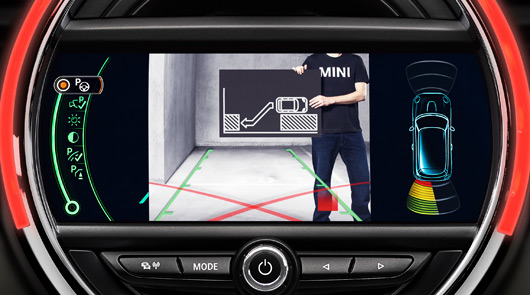
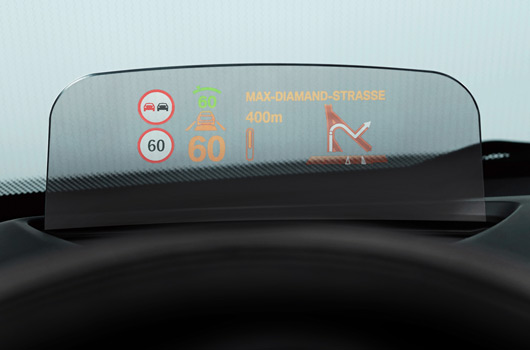
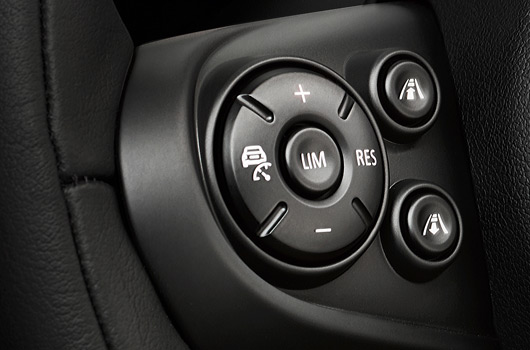
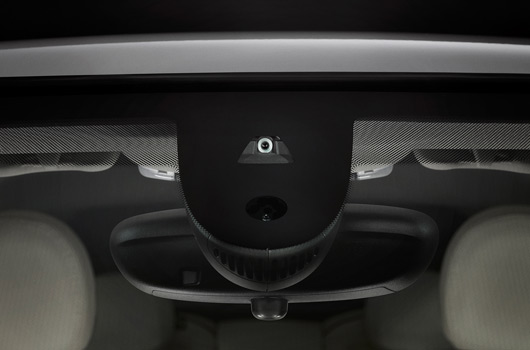
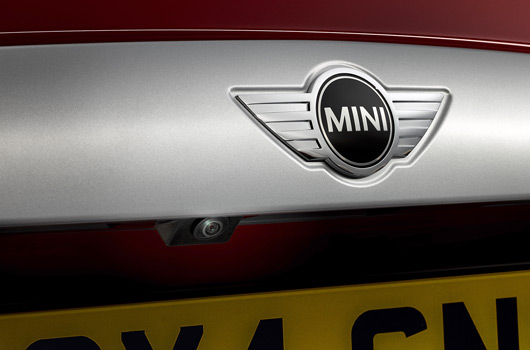
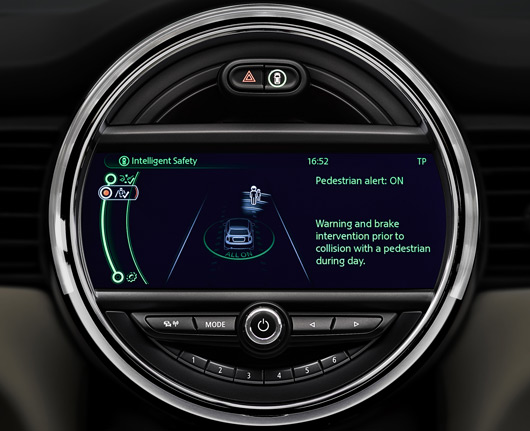
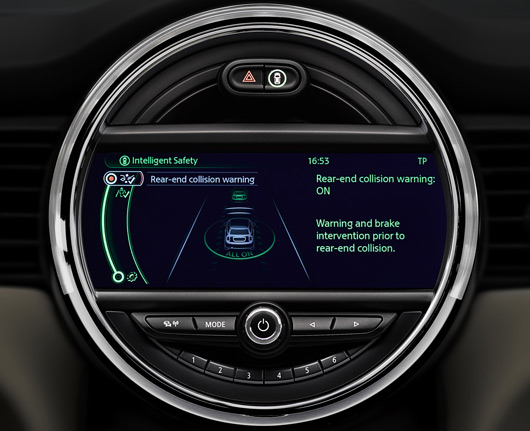
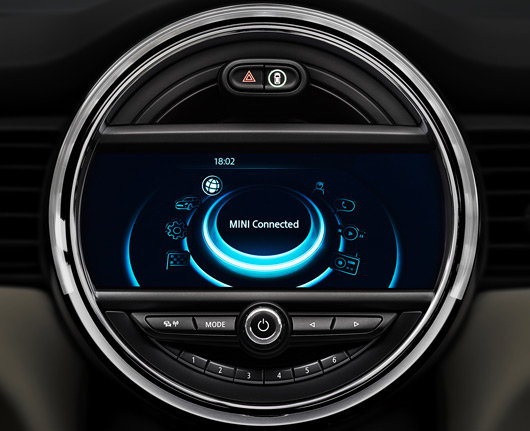
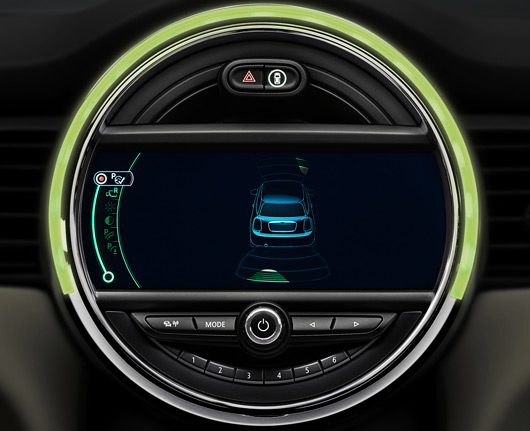
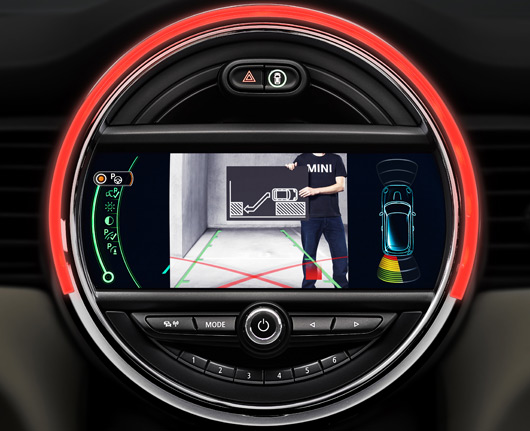
4 replies on “MINI reveals F56 driver assist technology”
The quality of the interior appear to be much better. Can’t wait to see the real thing.
If they can fix the reliability issues with the engine and renound squeaks and rattles this could be a great car.
Some of this stuff won’t make it here
[…] MINI reveals F56 driver assist technology […]